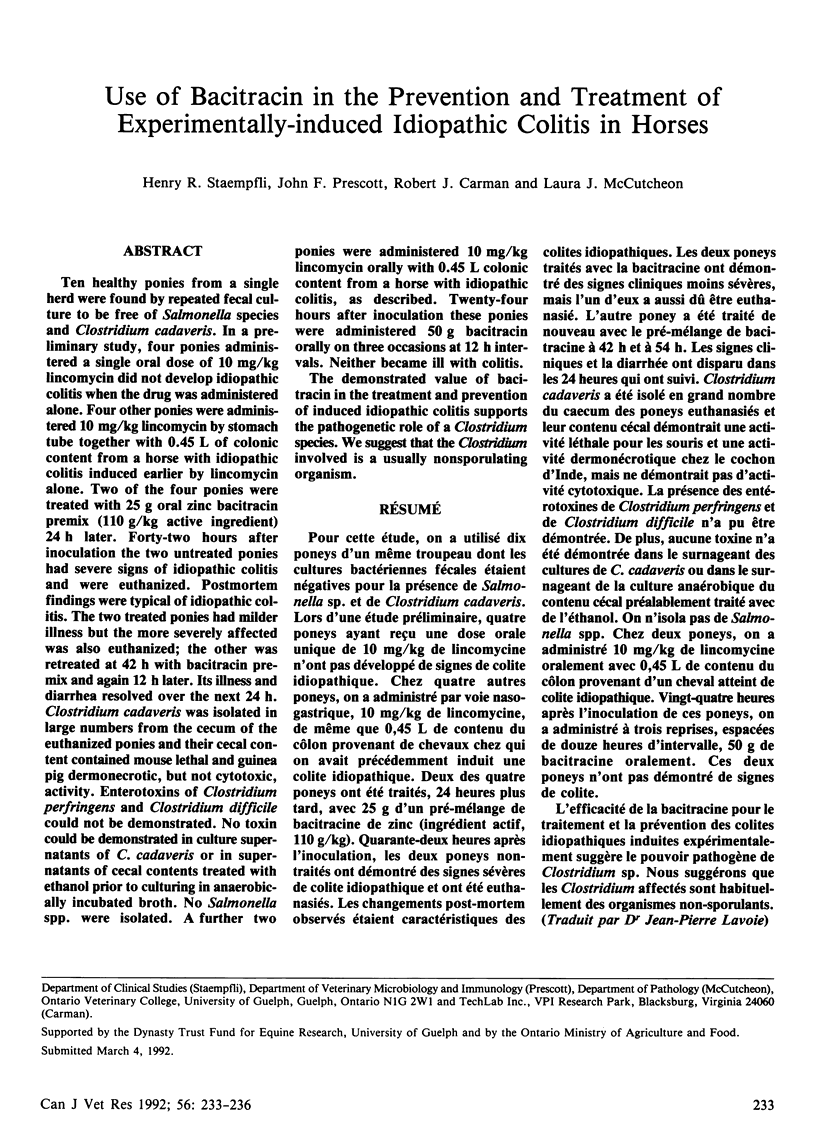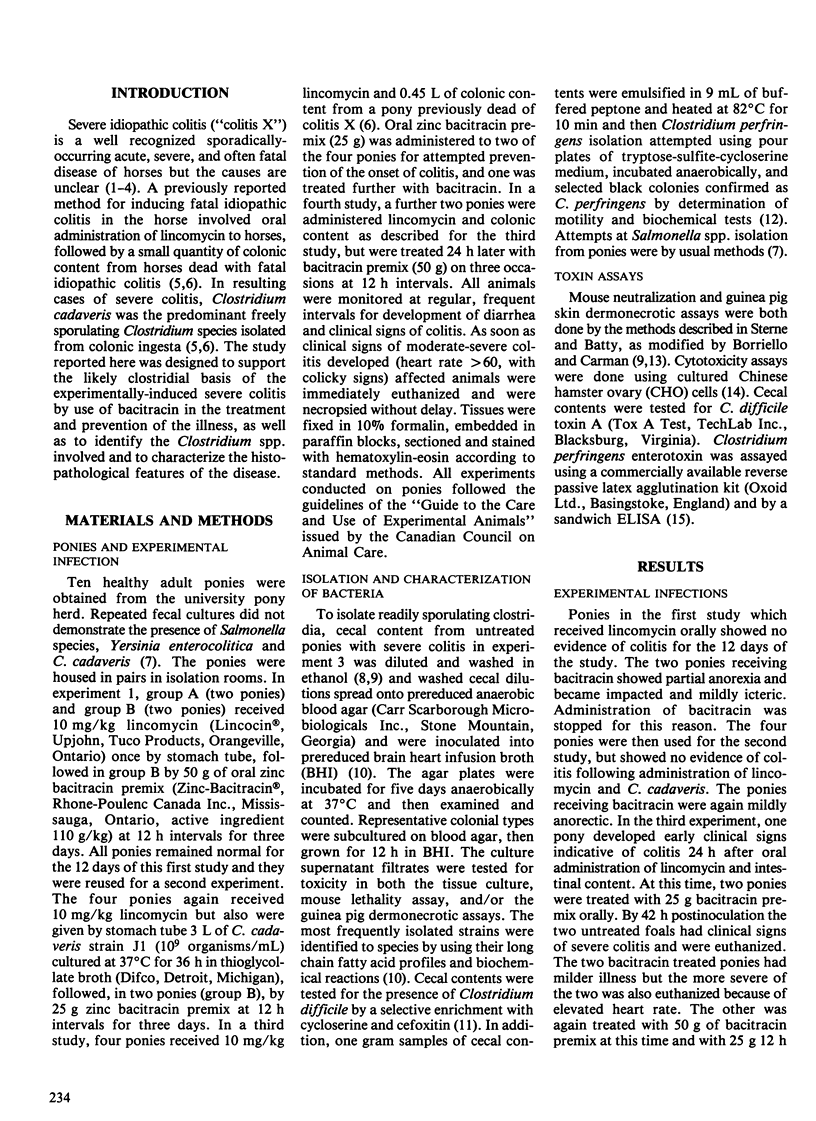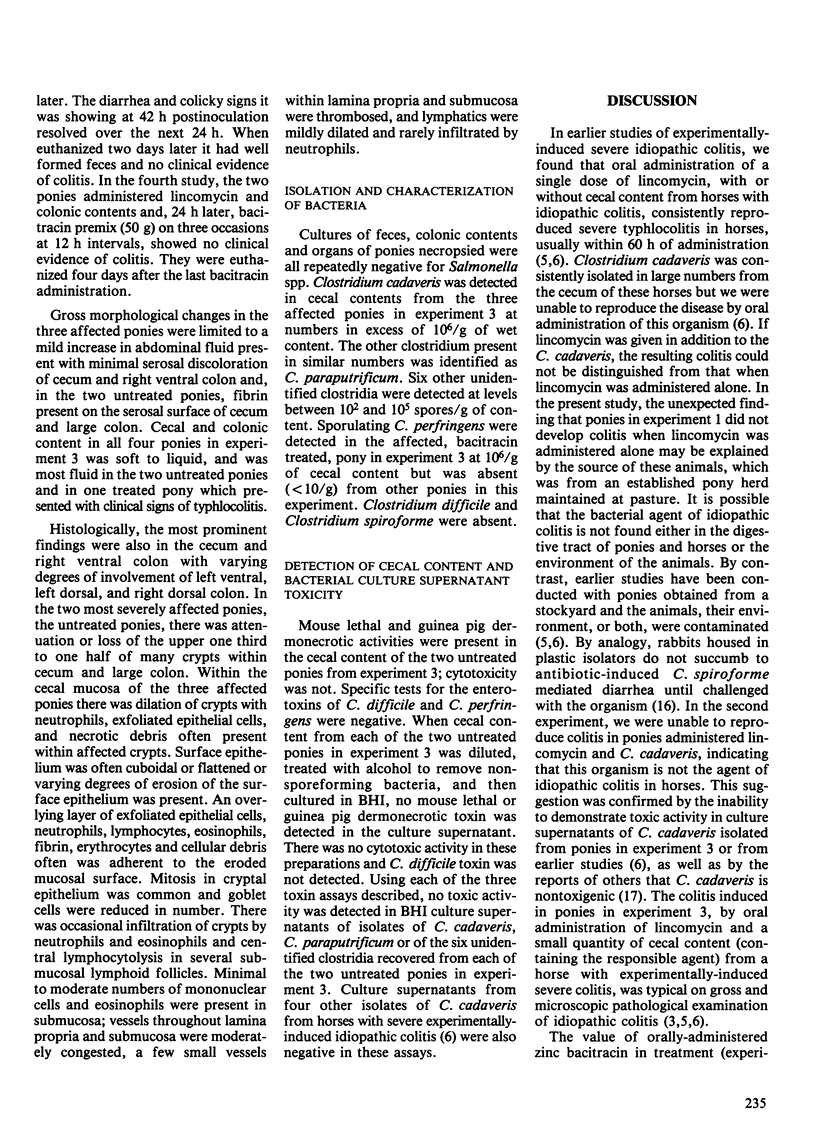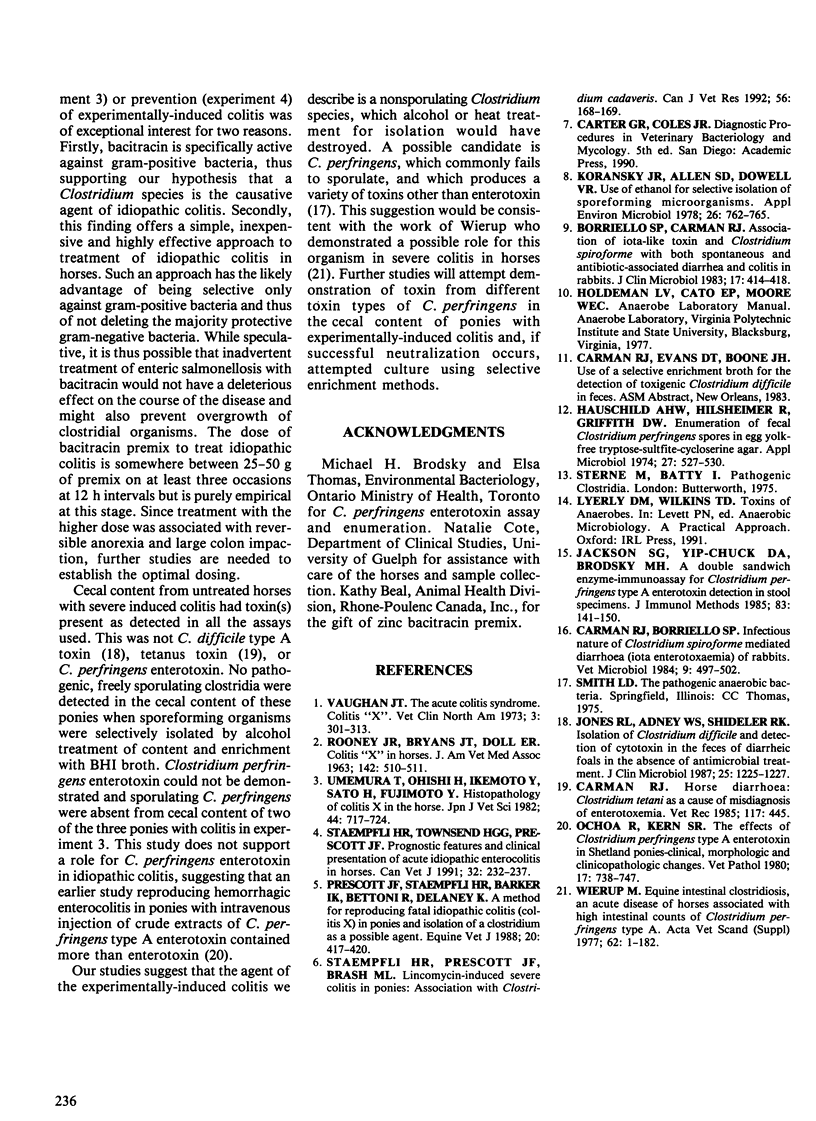Abstract
Ten healthy ponies from a single herd were found by repeated fecal culture to be free of Salmonella species and Clostridium cadaveris. In a preliminary study, four ponies administered a single oral dose of 10 mg/kg lincomycin did not develop idiopathic colitis when the drug was administered alone. Four other ponies were administered 10 mg/kg lincomycin by stomach tube together with 0.45 L of colonic content from a horse with idiopathic colitis induced earlier by lincomycin alone. Two of the four ponies were treated with 25 g oral zinc bacitracin premix (110 g/kg active ingredient) 24 h later. Forty-two hours after inoculation the two untreated ponies had severe signs of idiopathic colitis and were euthanized. Postmortem findings were typical of idiopathic colitis. The two treated ponies had milder illness but the more severely affected was also euthanized; the other was retreated at 42 h with bacitracin pre-mix and again 12 h later. Its illness and diarrhea resolved over the next 24 h. Clostridium cadaveris was isolated in large numbers from the cecum of the euthanized ponies and their cecal content contained mouse lethal and guinea pig dermonecrotic, but not cytotoxic, activity. Enterotoxins of Clostridium perfringens and Clostridium difficile could not be demonstrated. No toxin could be demonstrated in culture supernatants of C. cadaveris or in supernatants of cecal contents treated with ethanol prior to culturing in anaerobically incubated broth. No Salmonella spp. were isolated. A further two ponies were administered 10 mg/kg lincomycin orally with 0.45 L colonic content from a horse with idiopathic colitis, as described.(ABSTRACT TRUNCATED AT 250 WORDS)
Full text
PDF



Selected References
These references are in PubMed. This may not be the complete list of references from this article.
- Borriello S. P., Carman R. J. Association of iota-like toxin and Clostridium spiroforme with both spontaneous and antibiotic-associated diarrhea and colitis in rabbits. J Clin Microbiol. 1983 Mar;17(3):414–418. doi: 10.1128/jcm.17.3.414-418.1983. [DOI] [PMC free article] [PubMed] [Google Scholar]
- Carman R. J., Borriello S. P. Infectious nature of Clostridium spiroforme-mediated rabbit enterotoxaemia. Vet Microbiol. 1984 Sep;9(5):497–502. doi: 10.1016/0378-1135(84)90070-1. [DOI] [PubMed] [Google Scholar]
- Carman R. J. Horse diarrhoea: Clostridium tetani as a cause of misdiagnosis of enterotoxaemia. Vet Rec. 1985 Oct 26;117(17):445–445. doi: 10.1136/vr.117.17.445. [DOI] [PubMed] [Google Scholar]
- Hauschild A. H., Hilsheimer R., Griffith D. W. Enumeration of fecal Clostridium perfringens spores in egg yolk-free tryptose-sulfite-cycloserine agar. Appl Microbiol. 1974 Mar;27(3):527–530. doi: 10.1128/am.27.3.527-530.1974. [DOI] [PMC free article] [PubMed] [Google Scholar]
- Jackson S. G., Yip-Chuck D. A., Brodsky M. H. A double antibody sandwich enzyme-immunoassay for Clostridium perfringens type A enterotoxin detection in stool specimens. J Immunol Methods. 1985 Oct 24;83(1):141–150. doi: 10.1016/0022-1759(85)90067-5. [DOI] [PubMed] [Google Scholar]
- Jones R. L., Adney W. S., Shideler R. K. Isolation of Clostridium difficile and detection of cytotoxin in the feces of diarrheic foals in the absence of antimicrobial treatment. J Clin Microbiol. 1987 Jul;25(7):1225–1227. doi: 10.1128/jcm.25.7.1225-1227.1987. [DOI] [PMC free article] [PubMed] [Google Scholar]
- Koransky J. R., Allen S. D., Dowell V. R., Jr Use of ethanol for selective isolation of sporeforming microorganisms. Appl Environ Microbiol. 1978 Apr;35(4):762–765. doi: 10.1128/aem.35.4.762-765.1978. [DOI] [PMC free article] [PubMed] [Google Scholar]
- Ochoa R., Kern S. R. The effects of Clostridium perfringens type A enterotoxin in Shetland ponies--clinical, morphologic and clinicopathologic changes. Vet Pathol. 1980 Nov;17(6):738–747. doi: 10.1177/030098588001700609. [DOI] [PubMed] [Google Scholar]
- Prescott J. F., Staempfli H. R., Barker I. K., Bettoni R., Delaney K. A method for reproducing fatal idiopathic colitis (colitis X) in ponies and isolation of a clostridium as a possible agent. Equine Vet J. 1988 Nov;20(6):417–420. doi: 10.1111/j.2042-3306.1988.tb01563.x. [DOI] [PubMed] [Google Scholar]
- ROONEY J. R., BRYANS J. T., DOLL E. R. Colitis "X" of horses. J Am Vet Med Assoc. 1963 Mar 1;142:510–511. [PubMed] [Google Scholar]
- Staempfli H. R., Prescott J. F., Brash M. L. Lincomycin-induced severe colitis in ponies: association with Clostridium cadaveris. Can J Vet Res. 1992 Apr;56(2):168–169. [PMC free article] [PubMed] [Google Scholar]
- Staempfli H. R., Townsend H. G., Prescott J. F. Prognostic features and clinical presentation of acute idiopathic enterocolitis in horses. Can Vet J. 1991 Apr;32(4):232–237. [PMC free article] [PubMed] [Google Scholar]
- Umemura T., Ohishi H., Ikemoto Y., Satoh H., Fujimoto Y. Histopathology of colitis X in the horse. Nihon Juigaku Zasshi. 1982 Oct;44(5):717–724. doi: 10.1292/jvms1939.44.717. [DOI] [PubMed] [Google Scholar]
- Vaughan J. T. The acute colitis syndrome. Colitis "X". Vet Clin North Am. 1973 May;3(2):301–313. doi: 10.1016/s0091-0279(73)50039-x. [DOI] [PubMed] [Google Scholar]
- Wierup M. Equine intestinal clostridiosis. An acute disease in horses associated with high intestinal counts of Clostridium perfringens type A. Acta Vet Scand Suppl. 1977;(62):1–182. [PubMed] [Google Scholar]


